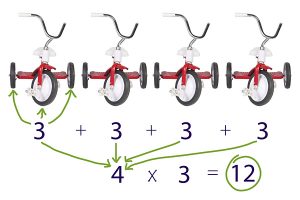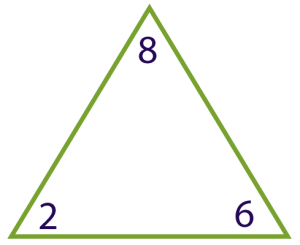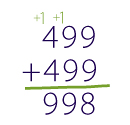Math at Home
Math at Home
The Rainbow District School Board Parent Involvement Committee has produced a a series of math tip sheets for helping your child at home.
Chapter 1
Math is fun and interactive
Math isn’t what it used to be. It is taught differently. To support your child at home, it’s important to understand why and how.Math class may bring back memories of working independently on math worksheets, memorizing and calculating. There was more focus on trying to follow the procedures being taught. Today, math class is more fun and much more interactive.
Children are engaged in meaningful mathematical tasks, often connected to real life situations. There is a greater focus on developing an understanding of math concepts, and then developing proficiency with strategies and procedures to solve mathematical problems.
In math class, your child is encouraged to develop his/her own problem-solving strategies. this often involves using concrete materials or drawing pictures to represent the concepts being presented.
Getting the correct answer is still important. However, with a focus on thinking, your child is gaining a deeper understanding of how to solve math problems, strategies he/she will retain for years to come.
Chapter 2
Fun and games
Playing games is one of the best ways to make math fun and engaging. When your child is playing a game, he/she is often having so much fun that he/she forgets that it’s math. Games are a great way to provide opportunities for practice and to support strategic thinking.
Board games and card games are fun ways for families to engage in math together. For example, cribbage is a great game to practice addition and use strategic thinking. Games can often be found at the local dollar store. Solving logic puzzles is also an excellent way to do math together.
Puzzles, such as sudoku, involve logic and reasoning, which are valuable skills to develop. You can often find puzzles in the local newspaper. If your child enjoys using the computer, spend some time together checking out online games and search for free games that your child enjoys playing that allow him/her to practice math. Enjoy the math games being sent home with students in Grades 1 to 6.
When games are played co-operatively, rather than competitively, your child is more likely to share his/her thinking and strategy. Take the opportunity to share your strategy to support your child’s thinking.
Chapter 3
We can all learn math
Having a positive attitude towards mathematics will encourage your child to believe he/she can be successful.
Just as children see themselves as readers and writers, we want them to see themselves as mathematicians. We can all learn math with the right time and support.
Parents/guardians are important role models in the learning process.
Make math fun
Let your child see the fun side of math.
Share times when you use math at home, at work, and in the community. Engage in math together by playing games, doing puzzles, looking for patterns and just playing with numbers.
Let your child see that you enjoy the challenge math can bring.
Show him/her that you struggle at times, that you are willing to try and to take risks, and that you enjoy the thinking that is involved in solving a mathematical problem.
Be positive
When your child is working on math homework, maintain a relaxed and positive attitude.
Encourage your child to persevere. Success will come.
Praise your child for his/her effort. Put the emphasis on the process and for working hard, not on getting the correct answer.
Feeling successful and having fun are the best ways for your child to develop a love of math and a belief in his/her ability to do math.
Chapter 4
Math is everywhere
Children often believe that math is a subject they only learn in school. Help your child see math in everyday life and how it connects to the math he/she is learning at school.
The kitchen is a great place to start.
Provide opportunities for your child to use various measuring tools when cooking, read nutritional information on food packaging, and check out the grocery store flyers to find the best prices on favourite foods.
There are many ways to see math in everyday life.
Talk to your child about how he/she may spend or save money.
Go on a geometry hunt to see what shapes and figures you can spot in your home or neighbourhood.
When reading the newspaper, look at some of the graphs and tables and think about the information you are receiving from the data, and what you are still wondering.
There are lots of opportunities to measure – buying paint, moving furniture and building projects.
When you’re out for a walk or drive, look for numbers and talk about what they mean, everything from house addresses, to speed limit signs, to prices.
When you stop to put gas in your car, talk about how many litres the tank holds, how many litres of gas you put in, the price of the fuel, and the mileage your vehicle gets. When you take the bus, calculate the cost of all the riders put together at one time.
The world of sports provides tons of opportunities to talk about math – from scores to stats. If your child has a favourite team or player, use that as a way to engage in a conversation about math. Predict the probability of the next win!
The more you help your child to connect the math he/she learns in school with the math in everyday life, the more he/she will see it as a meaningful part of his/her world.
Chapter 5
Talking leads to understanding
To support your child in understanding math, you will want to get him/her talking.
Ask questions
Asking your child questions is a great way for you to learn how he/she is thinking through the problem.
You may ask:
- What are you thinking?
- What strategy are you using?
- How do you know?
- What was the most challenging part of this task?
When your child is stumped, rather than telling him/her what to do, ask your child what he/she is thinking:
- What do you already know?
- What picture or model might help you solve the problem?
- What do you think you could do to get started?
- Does this remind you of a similar problem you have solved?
Let your child be the teacher
The best way to really understand something is to teach it to someone else. Let your child explain the math to you. While your child is talking, you can ask questions to show your genuine interest in understanding what he/she is teaching you and that you respect his/her way of thinking.
Focus on understanding
While math involves many procedures, it is important that your child develops an understanding of the mathematics first and then takes time to practice.
When you ask questions and encourage your child to talk about the math he/she is doing, your child will realize that you value his/her way of thinking. Your child will gain confidence in his/her ability to do math.
Chapter 6
See the math
The best way to help your child make sense of math is to connect pictures or models to the symbols and language of mathematics.
There are many ways to create images, called representations, of mathematics processes.
Make a picture in your head
Just as we encourage students to make pictures in their head when they are reading, we encourage them to make pictures in their head when they are trying to understand mathematical concepts.
If your child is learning about fractions, try this activity:
- Ask your child to make a picture that represents one quarter in his/her head. You can make a picture too.
- Now tell your child to erase that picture and make a new picture to represent one quarter.
- Tell each other about the pictures you made.
Was it a 25 cent coin, a pie with one quarter eaten, a measuring cup with ¼ cup of milk?
Use a model
Sometimes creating a model of the math, rather than looking at a picture in a book, helps your child to understand the concept being presented.
If your child is learning about 3D figures – cubes, cones, spheres – look for similar shapes in your home and see what you can find.
Older students may be learning about volume. Using building blocks will allow your child to create a model of volume.
If your child is learning how to measure length, ask him/her to show you 1 cm, 10 cm and 1 m.
Whenever your child is engaged in math, be sure to encourage him/her to see the math.
Chapter 7
Make connections
Just as we encourage children to make connections when they are reading, encourage your child to make connections when he/she is doing math.
Connect to math you already know
Math concepts are often connected. If your child is learning about multiplication for the first time, help him/her think about what he/she knows about addition or skip counting to help him/her solve the problem.
When a child is learning to multiply, he/she can think about a fact he/she knows to help with other facts.

For example, if your child is trying to solve 6 x 5, ask him/her to think about how he/she can use 5 x 5 = 25 to help.
If your child knows how to add 4 and 3, ask him/her to think about how he/she can use this to help add 40 and 30, or 400 and 300.
Connect to a similar question
When your child encounters a challenging math question, ask him/her to think about other questions he/she has solved that are similar.
Connect to pictures
It is always a great idea to encourage your child to draw a picture, or to picture in his/her head, the mathematics that he/she is learning. When children are trying to solve a problem, this is one of the best ways to help them get started.
Connect math to daily life
Help your child think about how the math he/she is learning at school connects to math in his/her daily life. Share times when you use math.
Chapter 8
Solving Problems
Children sometimes think if they don’t know the answer right away, they can’t do math.
We need to help them understand that everyone can excel at math.
There are steps that we go through as we solve a problem. Helping your child think about this process will support him/her in seeing himself/herself as a capable mathematician.
Understanding the problem
Children are encouraged to:
- Read the problem and then restate the problem in their own words.
- Create a model or make a picture in their head to show the problem.
- Ask themselves the following questions:
– What do I know?
– What do I have to find out?
– What information will I use?
– How can I get started?
Make a plan
Your child may think there is one way to solve this problem. Help him/her to see that he/she can use any strategy that makes sense to solve the problem.
Carry out your plan
Have your child go ahead and work on the problem. You may find that you have to reread the question or change your plan as you go. That’s okay. It’s all part of the problem solving process.
Does your answer make sense?
- Have your child check to make sure he/she answered everything that was asked.
- Children are encouraged to ask themselves if their answer makes sense.
- Think about whether there might be an easier, or more efficient way to solve the problem.
Problem solving demands perseverance, reasoning, analyzing, representing and questioning.
These are great thinking skills for your child to develop. They will be valuable in all areas.
Chapter 9
Get the facts
In math, when focusing on relationships, there are fewer facts to remember.
The best way to ensure your child knows all the facts is to support him/her in learning the mental strategies taught in class with a focus on relationships.
Make it easy by using what you know
Start by helping your child determine just how many facts he/she already knows. For example, most students know how to add in combinations of ten, and how to add 1 or 2 to a number.
Make sure your child realizes that when he/she is adding or multiplying, it doesn’t matter what order the numbers are in.
If you know 3 x 4, you know 4 x 3. This reduces the number of facts to learn by half.
For more challenging facts, encourage your child to connect to a fact he/she already knows. For example, if your child knows 8 + 8 = 16, ask him/her to think about how he/she could use that to figure out 8 + 9 (8 + 8 + 1 more = 17).
This strategy also works for multiplication. If your child knows 2 x 6, he/she can use this to help him/her figure out 3 x 6 (3 x 6 is 2 x 6 plus one more group of 6; 12 + 6 = 18)
Connect the operations
Children often feel more comfortable with addition than subtraction, or with multiplication than division.

Triangle flash cards are a great way to help your child make the connection between the operations. This will make it easier to learn the facts. Put your finger over the 8 and ask “What is 2 + 6?”
Then, put your finger over the 2 and ask “What is 8 – 6?”
Create strategy flash cards
Rather than trying to learn all the facts at once, have your child select five facts that he/she would like to learn. Record each fact on a slip of paper. On the back, have your child record the strategy he/she will use to help learn that fact. When your child takes time to practice, he/she can focus on this small set of facts. As he/she learns each one, more strategy flash cards can be created.
Chapter 10
Computation
There are fast and easy ways for adding, subtracting, multiplying and dividing larger numbers when we use mental math strategies.
Many adults were taught that the only way to perform operations with greater numbers was to use standard algorithms, a set of procedures for carrying out a computation.
In other countries, however, different algorithms are used.
Your child may be able to come up with his/her own strategy, called a student-generated algorithm, that actually makes it easier for him/her to find the answer.
For example, if your child is trying to solve 499 + 499, rather than writing the numbers vertically and using the carrying method we learned:

Your child might use his/her understanding of numbers and think 500 + 500 = 1000, so the answer is 1000 – 2 = 998. This type of strategy involves thinking about numbers as quantity, for example, 499 is almost 500, rather than just thinking about digits. When students think about quantity, rather than relying on procedures, they are less likely to make errors.
It’s not easy to solve the traditional way.
But if your child uses counting up, 3997 + 3 = 4000, plus one more = 4001, the answer is 3 + 1 = 4.
These student-generated strategies also work for multiplication and division.
Rather than using the long division algorithm to solve 3248 ÷ 16, your child might think 16 x 100 = 1600, 16 x 200 = 3200, 16 x 3 = 48.
The goal is for your child to develop efficient and accurate strategies for multi-digit computation, and flexibility working with numbers. Based on the numbers in the question, your child will use a different strategy.
Rather than showing your child the procedures you learned in school, ask your child to share his/her strategy and to think about how efficient and easy it is to use and how it connects to traditional strategies. This is a great opportunity for your child to teach you some math.
Math Games

 Translate
Translate